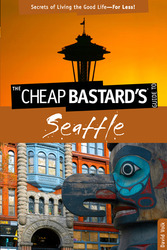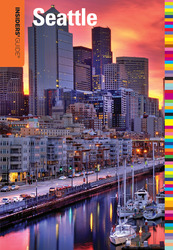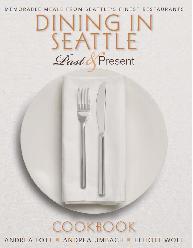Three ambitious books are about to hit the market, purporting to tell you where to eat, drink, shop and live in Our Fair City. Some solid hits, some wild misses.
 The "Fearless Critic" franchise, launched by New York wine writer Robin Goldstein, is a puzzling series, guidebooks to local restaurants ostensibly written by "undercover local critics who dine incognito." The authors of the inaugural Seattle guide, however, are reasonably well-known around town, have their own blogs and write for mainsteam publications like Seattle Weekly and Seattle Metropolitan. That's not the puzzling part, though. Helpfully organizing the 250 local eateries by neighborhoods, Fearless Critic assigns Blueacre Seafood (7th & Olive) to Belltown on the argument that it's north of Virginia (not so! it's at 7th and Olive), but keeps Etta's, which really is north of Virginia, in Downtown. Attempting to categorize restaurants by poshness, Le Pichet is called Upmarket while the spare yet elegant Sitka & Spruce qualifies as Casual, as does Le Pichet's sibling, Cafe Presse. The selection is full of obscure taverns and coffee shops, and a widearray of Asian eats (Canton Noodle House, Chiang's Gourmet, Fu Man Dumpling House, Hing Loon, and on and on).
The "Fearless Critic" franchise, launched by New York wine writer Robin Goldstein, is a puzzling series, guidebooks to local restaurants ostensibly written by "undercover local critics who dine incognito." The authors of the inaugural Seattle guide, however, are reasonably well-known around town, have their own blogs and write for mainsteam publications like Seattle Weekly and Seattle Metropolitan. That's not the puzzling part, though. Helpfully organizing the 250 local eateries by neighborhoods, Fearless Critic assigns Blueacre Seafood (7th & Olive) to Belltown on the argument that it's north of Virginia (not so! it's at 7th and Olive), but keeps Etta's, which really is north of Virginia, in Downtown. Attempting to categorize restaurants by poshness, Le Pichet is called Upmarket while the spare yet elegant Sitka & Spruce qualifies as Casual, as does Le Pichet's sibling, Cafe Presse. The selection is full of obscure taverns and coffee shops, and a widearray of Asian eats (Canton Noodle House, Chiang's Gourmet, Fu Man Dumpling House, Hing Loon, and on and on).
Some entries sound like they were rewritten back at headquarters. Flying Fish, now in South Lake Union, was never part of the Pike Place Market "tourist trap." (And why do writers keep referring to the city's leading attraction as a if it were a den of iniquity or a disgusting swamp?)
On the other hand, there are enough snarky remarks to keep you reading. Kingfish Cafe "cuisine no longer dazzles." Delancey "isn't worth the two-hour wait." (Oh yes it is.) Service at Harvest Vine is spotty. Wild Ginger's food is dated; its kebabs too dry, its noodles too wet, but its wine list is "a work of profound beauty, elegance.and deep obsession...a gift to the city." (The wine lists at Canlis, Rover's, Daniel's Broiler, Cafe Juanita and Spinasse also get high praise.)
The best French restaurant in town, according to FC, is Le Pichet, described as a simple bistro (and yet, as noted, categorized as "Upmarket Restaurant") with "masterful" food.
It would be hard to disagree with FC's top choices for "Most Delicious." Cafe Juanita leads the list, followed by Joule (Jay Friedman's avowed favorite), Crush, Le Pichet, Sitka & Spruce, Spinasse. For "Good Vibes," there's some overlap; Le Pichet, Sitka & Spruce and Spinasse lead the list. Friedman probably could have written the book on the basis of his own blog alone; he's closing in on 400 reviews posted on Gastrolust.com, twice as many as second-place Cornichon (the blog you're reading now, meathead).
Fearless Critic's local editor, Carissa Bluestone, knows how to wrangle a consensus out of the advisory panel (and it's a prestigious group: Seattle Food Geek, Surly Gourmand, Lorna Yee among others), with Friedman serving as chief editorial voice. This manages to avoid the kinetic, frazzled style of the Zagat guides, though you get the feeling that the snarkiness is doled out in quarter-teaspoon doses. After all, if a restaurant were truly terrible, it doesn't deserve to be in the book in the first place. Which makes one wonder why so many "not particularly pleasant" strip-mall take-out joints are featured, be they Chinese, Japanese, Indonesian, Laotian, Thai, Filipino, Korean or Vietnamese.
The good news is that updates are posted regularly on the Fearless Critic website, and the whole book is also online for a modest subscription.
 And then we have the Cheap Bastard series from Globe Pequot, with the estimable David Volk recruited to compile and write the Seattle edition. Volk has to live up to his reputation as a humorist, so some of the capsule reviews are a bit forced, but in general this it's an impressive compilation.
And then we have the Cheap Bastard series from Globe Pequot, with the estimable David Volk recruited to compile and write the Seattle edition. Volk has to live up to his reputation as a humorist, so some of the capsule reviews are a bit forced, but in general this it's an impressive compilation.
The reader is torn between Volk's put-upon persona as he struggles to uncover one bargain after another, and admiration for the results. Best bargain, he says, is the Seattle International Film Festival, which offers free seats to volunteers. (Volunteering is a great way to see live theater, too.) One freebie new to me were the online language lessons from Mango Languages via the Seattle Public Library website, www.spl.org. No need for expensive Rosetta Stone if what you want is a quick refresher. Volk helpfully lists addresses for all the branch libraries, restaurants where kids eat free, and tries to get his arms around Seattle's strangest institution, Happy Hour. He gives it ten pages of listings. More good stuff: thrift stores and consignment furniture shops, cheap haircuts, and a list of websites that find good deals, day in and day out.
 Next up: The Insider's Guide to Seattle, penned for the Globe Pequot series by Shelley Seele, a journalist whho started her career in Austin, Texas, and whose previous book concerned children living in the slums of India. She moved to Seattle, learned enough about the city to start writing for far-away magazines.
Next up: The Insider's Guide to Seattle, penned for the Globe Pequot series by Shelley Seele, a journalist whho started her career in Austin, Texas, and whose previous book concerned children living in the slums of India. She moved to Seattle, learned enough about the city to start writing for far-away magazines.
I don't know where she got the notion that Greenlake is connected to Lake Union by water; perhaps she knows things I don't. Belltown's "gritty urban scene"? A matter of opinion. The book's publication date is December, 2010, yet Washington Mutual--seized by federal regulators two years ago--is listed as a major employer. Alex Haley, to take another entry, was never a Seattle resident; he merely died here. On the other hand, she notes that locals don't carry umbrellas.Yes, into each life a little drizzle must fall.
 Finally, a bit of nostalgia, published earlier this year. It's the Dining In Seattle Past & Present Cookbook from Elliott Wolf's Peanut Butter Publishing. The "Dining In..." series was launched in 1977 to give diners the recipes from their favorite restaurants. It ended up covering 38 volumes in 30 cities. Public attitudes have changes in the 25 years since the first book was published, attitudes toward cooking, toward ingredients, toward "classical" cuisine. So the book is in two parts, one historical, one contemporary. Present day is represented by the Usual Suspects (Cafe Juanita, Canlis, Metropolitan Grill, Wild Ginger). More interesting for some of us: Brasserie Pittsbourg's menu (Quenelles Nantua, $8.25; Cervelle de Veau aux Capres, $8.25, Gigot d'Agneau Provençale, $9). The survivors, Canlis, celebrating its 60th anniversary this month. and The Georgian , whose chef at the time, Ludgar Szmania, signed his name to a menu featuring $14.50 foie gras and grilled lamb chops with kidneys, $21.50.
Finally, a bit of nostalgia, published earlier this year. It's the Dining In Seattle Past & Present Cookbook from Elliott Wolf's Peanut Butter Publishing. The "Dining In..." series was launched in 1977 to give diners the recipes from their favorite restaurants. It ended up covering 38 volumes in 30 cities. Public attitudes have changes in the 25 years since the first book was published, attitudes toward cooking, toward ingredients, toward "classical" cuisine. So the book is in two parts, one historical, one contemporary. Present day is represented by the Usual Suspects (Cafe Juanita, Canlis, Metropolitan Grill, Wild Ginger). More interesting for some of us: Brasserie Pittsbourg's menu (Quenelles Nantua, $8.25; Cervelle de Veau aux Capres, $8.25, Gigot d'Agneau Provençale, $9). The survivors, Canlis, celebrating its 60th anniversary this month. and The Georgian , whose chef at the time, Ludgar Szmania, signed his name to a menu featuring $14.50 foie gras and grilled lamb chops with kidneys, $21.50.
Thanks for rounding these up and giving them a once over, as only you can! Might make worthwhile holiday gifts, I'm thinking.